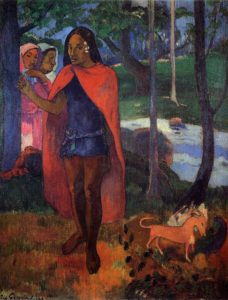Paul Gauguin- The Sorcerer of Hiva Oa (1902)
Featured Artwork: The Sorcerer of Hiva Oa (Marquesan Man in the Red Cape)
 Date & Location: 1902 in Hiva Oa, an isle in French Polynesia
Date & Location: 1902 in Hiva Oa, an isle in French Polynesia
Media: Oil painting
Significance to Queer Art History: This painting’s inspiration was drawn from Gauguin’s travels from France to the Polynesian Islands where Gauguin thought the lives and surroundings would be “untouched” by European influence and colonization. This painting depicts a māhū individual from Hiva Oa (not a man in a cape, as Gauguin describes the individual to his western standards of gender) who identifies with a third gender that can encompass both male and female roles, presentation, and even some spiritual aspects as māhū individuals were revered as healers as this person that Gauguin describes as a “sorcerer”.
Symbolism to note: The conversing fox and bird at the bottom right of the image are natural enemies with many differences. This is perhaps Gauguin’s way of portraying male and female genders “conversing” and getting along with one another to symbolize the māhū individual’s gender.
Editors Note: Gauguin’s view into the lives of the indigenous folks of Hiva Oa and the areas he visited in the Polynesian Islands may be untruthful and deemed offensive as he often exploited spiritual and cultural practices and added his own westernized European influences and concepts to his works while traveling to “un-touched” and un-colonized (the Polynesian Isles had already been colonized years before by the French) areas.
Resources & Further Reading:
Reed, Christopher. “Gender- Transcendant Homosexuality: Polynesia and North America.” In Art and Homosexuality: A History of Ideas. Oxford: University Press, 2011.
“The Men-women of the Pacific.” Tate. Accessed August 2017. http://www.tate.org.uk/context-comment/articles/men-women-pacific.

